Koala

Koala Breeding Season
The peak koala breeding season in Southeast Queensland runs from July to January. During this period, koalas move around more, coming down from trees to find a new mate or new territory. Hence, we’re more likely to see them. Koalas are nocturnal, so they are most active between dusk and dawn.
You may see koalas crossing roads, navigating backyards, or getting caught in other dangerous situations.
We all share a role in the conservation of this iconic species. Help them on their journey by following some koala-friendly tips.
Quick Koala Facts
The koala's scientific name is Phascolarctos cinereus. Phaskolos means leather pouch, while arktos means bear. Cinerus means ashen grey in colour. However, it is important to note that koalas are not bears. They are planting eating marsupials that are well adapted to living in trees.
The koala is listed as endangered in Queensland, New South Wales and the Australian Capital Territory under the Federal Government’s Environmental Protection and Biodiversity Conservation Act 1999.
Under Queensland’s Nature Conservation Act 1992 the koala is listed as endangered.
In Queensland, koalas weigh between 5 to 10 kilograms and have short pale grey fur.
Adult male koalas are noticeably larger than adult female koalas, with a broader face and distinctly larger black nose, and can easily be distinguished by the large scent gland on their chest.
For more information about koalas, please visit Queensland Government - Koala.
Koalas in Logan
Koala’s have been recorded across the City of Logan. Over 46 percent of the city’s properties are located within 1 kilometre of a known koala sighting (based on reports received from 1 January 2023 to 31 December 2023). So even though we don’t see koalas all the time, we know they live close by to us. We can all play a role in keeping them safe.
The five suburbs with the highest number of reported koala sightings in 2023 were:
- Bahrs Scrub - 49 koala sighting reports
- Logan Village - 30 koala sighting reports
- Jimboomba - 25 koala sighting reports
- Mount Warren Park - 23 koala sighting reports
- Mundoolun - 18 koala sighting reports
If you see koalas in your yard, park or suburb then join the 2024 Logan Koala Count and report your sighting.
Council has used trained koala scat detection dogs to search some parks in Logan to learn about where koalas live. The Atlas of Living Australia has the results of these searches. Logan's koala population is significant on a regional scale due to its genetic uniqueness.
Although koalas prefer to stay in large patches of bushland, they can often be found in trees adjacent to waterways, in strips of roadside vegetation, in strands of trees in local recreation parks, and even in isolated gum trees in paddocks.
Koalas can move through open space, provided they are supported by suitable shelter trees and can move from patch to patch freely. Hence, it is important that some degree of connectivity is maintained across landscapes.
Koalas are still prevalent in many urban areas, surviving in often small and disconnected remnants of bushland. Highly urban suburbs including Springwood and Slacks Creek have recorded koala sightings, as have emerging urban areas such as Bahrs Scrub and Yarrabilba.
Koalas are also abundant in many rural areas, including Stockleigh, Jimboomba, Tamborine, Greenbank, Munruben and Mundoolun.
Koalas have been recorded in many parks in the City including, but not limited to:
- Daisy Hill Conservation Park, Daisy Hill
- Springwood Conservation Park, Springwood
- Meakin Park / Slacks Creek Environmental Park, Slacks Creek
- Alexander Clark Park, Loganholme
- Alexander Watt Park, Bannockburn
- Wuruga Reserve, Beenleigh
- Noyer Park/ Mount Warren Oval, Mount Warren Park
- Mount Warren Environmental Reserve
- Quinzeh Creek Park, Logan Village
- Jerry’s Downfall, Park Ridge South
- Wearing Park, Munruben
- Flesser Reserve, Park Ridge South
- Birnam Range Reserve, Jimboomba
- Baker Reserve, South Maclean
- Spring Mountain Forest Park, Greenbank.
Koalas are difficult to see. If you go searching for koalas in Logan, look for these signs that show a koala might be in the area:
- scratch marks on trees (these may also be from goannas or possums). To see an example of koala scratch marks visit Koala-scratches 4 | Koala Action Gympie Region
- koala scats (poo) around the base of trees (these are bullet-shaped and smell of eucalyptus if they are fresh). To learn how to identify koala scat, please visit What scat is that?
- listen for the bellow of the male koala during breeding season (to hear a male koala, please visit YouTube - Koala mating call at Taronga.
To learn more about how to see and survey koalas, check out this webinar featuring koala expert Dr Sean Fitzgibbon. If you do see a koala, don’t forget to Report wildlife sightings.
Check out this list of children books featuring koalas, available from our local library.
Threats to koalas
Koalas face ever increasing threats to their survival. These include:
- habitat loss and fragmentation, which can be caused by clearing for urban development, as well as the spread of invasive weeds and changes to bushfire intensity, leads to the isolation of individuals and populations. Habitat loss and fragmentation forces koalas to move into unfamiliar territory, making them more susceptible to other threats listed below
- vehicles strikes. When koalas come down from trees, they are forced to regularly cross busy roads to find food, shelter, mates within their home range
- domestic dogs can injure or kill a koala that is moving along the ground between trees. These incidences are most likely to occur during koala breeding season and in backyards. However, they also occur in parks
- disease, which threatens the resilience of koala populations. The two diseases which are widespread among koalas are:
- chlamydiosis - symptoms include reduced eye infections (leading to blindness), urinary tract infections (leading to infertility in females) and respiratory infection
- koala retrovirus (KoRV) – which suppress the immune system. This can be genetically transmitted between koalas and from parent to offspring
- backyards, which can present many barriers to safe koala movement
- fences that are not wildlife friendly can make it difficult for koalas to escape an enclosed yard
- pools are also a danger to koalas as they can quickly drown if they accidentally fall in and they don't have an easily way to climb out.
How are we helping koalas in Logan City?
To help protect koalas across the City of Logan, Council is:
- protecting and increasing koala habitat, including the acquisition of properties in Bahrs Scrub, Greenbank and Tamborine
- creating the following Koala Nature Refuges
- Cornubia Forest, Cornubia
- Leslie Parade Park, Slacks Creek
- Henderson Reserve, Jimboomba
- Murrays Environmental Reserve, Tanah Merah
- Berrinba Wetlands, Browns Plains
- increasing knowledge of koalas by hosting environmental events. These events include tree plantings, educational talks and conservation walks
- raising community awareness of koala movement during koala breeding season through the Koala Breeding Season Campaign. The campaign includes roadside banners, park information signage, digital posters and social media posts
- supporting koala carers through the EnviroGrants program. To find more information about koala carers, watch the YouTube video
- working with land owners to keep or plant more koala friendly vegetation. See Environmental Conservation Partnerships for information about how we help land owners do this
- improving our understanding of koala distribution across Logan by encouraging koala sightings, including the annual community koala count
- enabling safe movement of koala across roads by working with road authorities on mitigation actions, such as installing fauna crossings, fencing and raising driver awareness
- reducing the number of koala and dog encounters by raising the awareness of dog owners through the promotion of the LeaveIt program
- maintaining fodder plantations across the city to provide wildlife carers with a food resource for koalas in care
- managing pest plants and animals that may impact koalas or their habitat
- rehabilitating and restoring cleared or degraded land, including a focus on delivering koala habitat in key locations with environmental offsets.
Thermal drone surveys for koalas
Council will be conducting thermal drone flights to monitor and study native wildlife, such as koalas and greater gliders, and their habitats. Thermal imaging helps in detecting animals, especially nocturnal species, without disturbing them.
The aim of these surveys is to determine the distribution and abundance of koalas and greater gliders within key parks across the city. The data collected will help in the protection and management of these species, ensuring their long-term survival and resilience. Additionally, these surveys might identify critical habitat areas, track changes in wildlife populations over time, and contribute to broader ecological research.
The survey will be conducted by a team of experienced professionals who will ensure minimal disturbance to the wildlife and the surrounding environment.
Thermal drone flights are scheduled to take place across the following locations between the following dates and times:
- Daisy Hill Conservation Park, Daisy Hill and Neville Lawrie Reserve, Priestdale
29 April 2025 to 30 June 2025
9:00pm - 5:00am
During this timeframe potentially two drone surveys will be undertaken. Each individual survey will take one to two nights to complete.
- Cornubia Forest Park, Cornubia
1 May 2025 to 30 June 2025
9:00pm - 5:00am
During this timeframe potentially two drone surveys will be undertaken. Each individual survey will take one to two nights to complete.
- Kimberley Forest Park, Shailer Park
1 May 2025 to 30 June 2025
9:00pm - 5:00am
During this timeframe potentially two drone surveys will be undertaken. Each individual survey will take one to two nights to complete.
- Undullah Reserve, Undullah
1 May 2025 to 30 June 2025
9:00pm - 5:00am
- Mt Perry Conservation Park, Lyons
1 May 2025 to 30 June 2025
9:00pm - 5:00am
- Bahrs Hill Park and Summit Park, Bahrs Scrub
18 June 2025
10:00pm - 7:00am
Please note these dates and times are subject to change based on weather conditions and other factors. Please check for any updates to the schedule.
Learn how to be a koala-friendly dog owner
Dog and koala interactions usually result in koala injury or death. Backyards are the most common location for this to occur. As a dog owner, there are a few simple actions you can take to help keep your dog and koalas safe:
- always walk your dog on a leash, unless in a designated off-leash area
- keep your dog inside or enclosed in a section of the yard at night when koalas are more active
- train your dog in wildlife aversion. To find information about training your dog, visit Leave It
- move your dog out of sight if you see a koala and give them a chance to move on. Dogs can feel threatened and might react unexpectedly when a koala moves through their yard
- notify neighbours and Council of koala sightings in your area.
Make my yard safe for koalas
Koalas often travel through backyards to find food trees and mates. They face many obstacles and when on the ground are vulnerable. You can help koalas navigate your backyard safely by:
- creating koala-friendly fencing. Lean a post or pole that is at least 10cm thick against the fence to provide an escape route from an enclosed yard
- installing a thick rope, a floating object or poolside escape board for koalas to grab onto if they fall in the pool, check out this post from Wildlife Watchers for more details on how to DIY a pool escape
- planting or retaining trees in your yard. Trees will allow koalas a safe place to rest as they move through your yard
- letting your neighbours know if a koala has been spotted in your area
- joining one of our Environmental Conservation Partnership programs. Receive support and advice from council on creating a wildlife-friendly yard.
Know the signs of a sick/ injured koala
Symptoms of a sick or injured koala include:
- eyes are inflamed, red, puffy, crusty and/or weeping
- very dirty or wet bottom
- very skinny (if you can see their ribs or they appear skinny or wasted, they need help)
- sitting at the base of a tree for an extended period (if they look alert and healthy they may just be resting for a few minutes, wait at a distance and see if they move on. Koalas don’t usually stay on the ground for long periods)
- staying low down in the same tree for more than a couple of days
- not using all four limbs when climbing or walking.
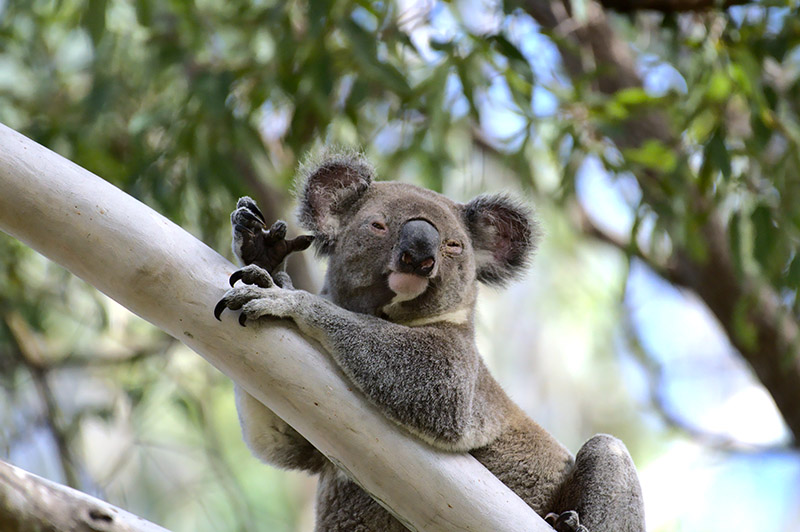
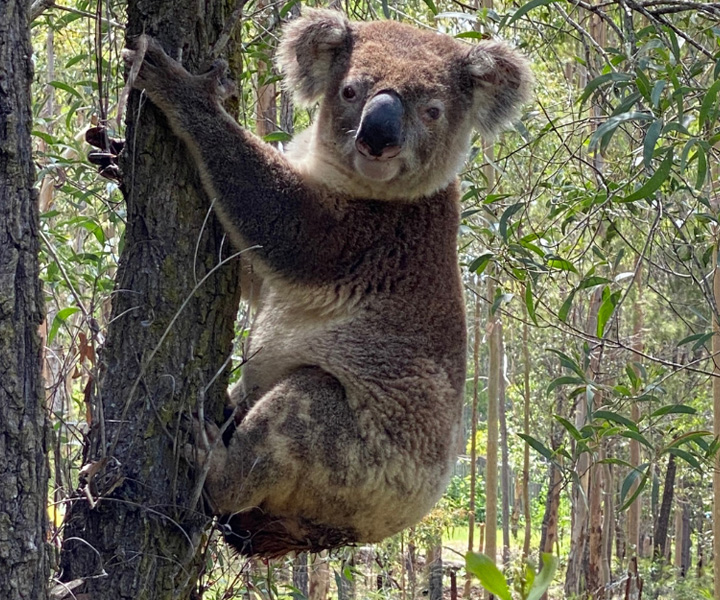
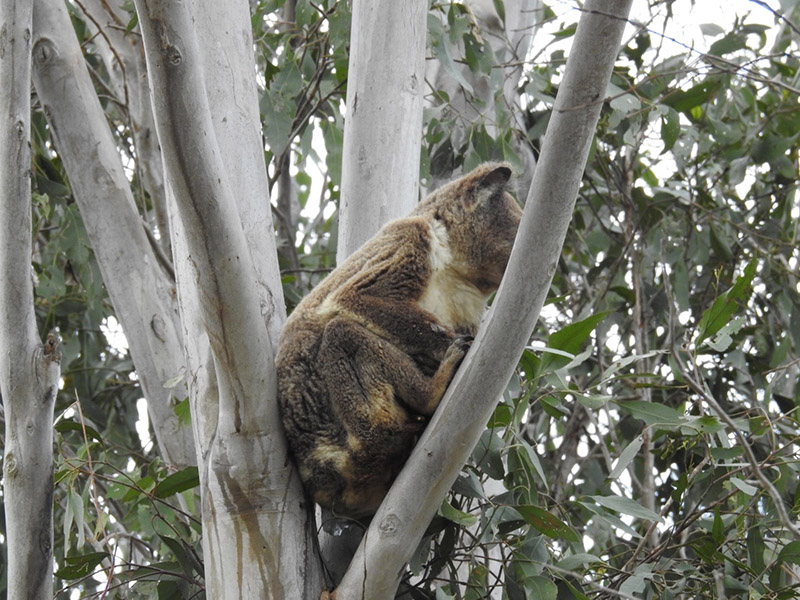

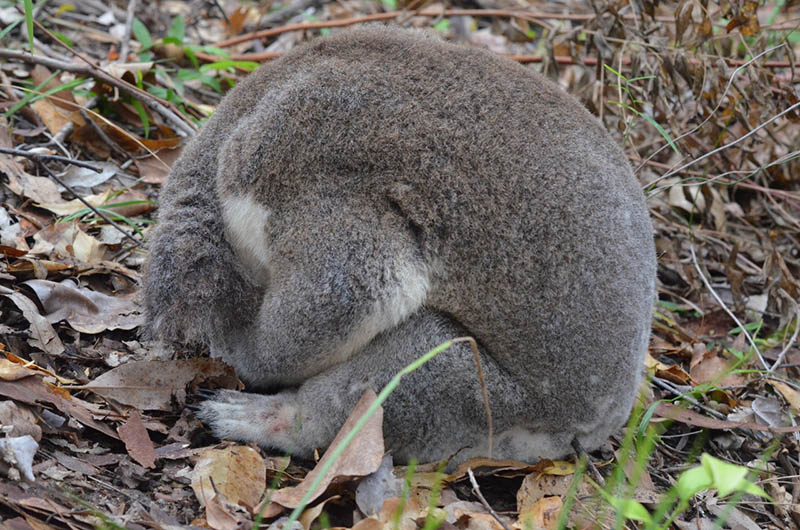
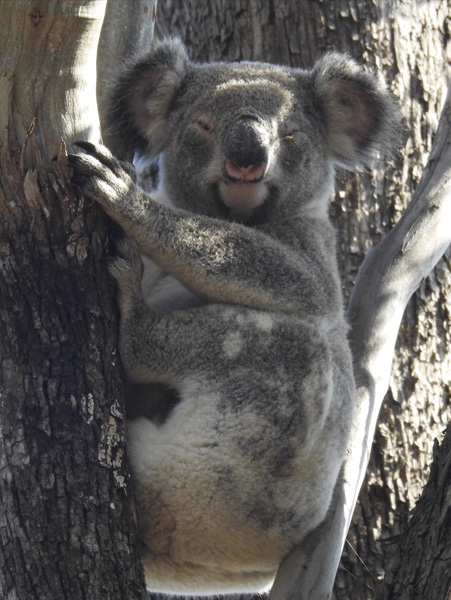
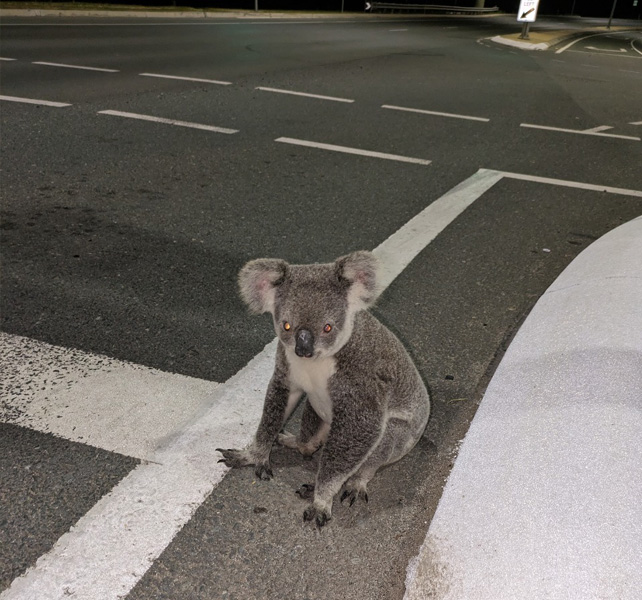
Learn how to be a koala-friendly driver
Koalas have little awareness of how dangerous a busy road can be. In many ways koala-friendly driving is just like driving through a school zone when school gets out. It involves:
- driving within the speed limit
- scanning the roadside for anything that may move onto the road or in front of your car. This is particularly important at dawn and dusk when koalas often travel and can be difficult to see.
- take note of any ‘koala zones’ in your area and slow down if you see yellow diamond or flashing koala road signs – these areas have a high concentration of koala activity.
Be mindful driving on Logan roads and take extra care on the following koala hotspot roads, especially between dusk and dawn:
- Bahrs Scrub Road, Bahrs Scrub
- Wuraga Road, Bahrs Scrub
- Hein Road, Buccan
- Camp Cable Road, Jimboomba
- Edelstein Road, Jimboomba
- Stockleigh Road, Logan Village
- Beaudesert Beenleigh Road, Mount Warren
- Beaudesert Beenleigh Road, Mundoolun
- Millstream Road, Mundoolun
- Mundoolun Road, Mundoolun
- Teviot Road, North Maclean
- Loganlea Road, Slacks Creek
- Waterford Tamborine Road, Tamborine.